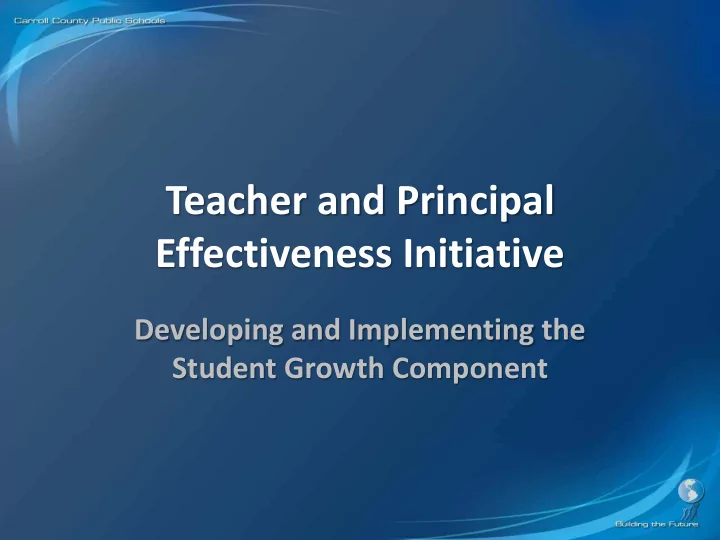

Teacher and Principal Effectiveness Initiative Developing and Implementing the Student Growth Component
Why Change? • Education Reform Act 2010 • Race to the Top • CCPS need to update criteria and process for both teachers and principals 2
Performance Evaluation Criteria 50% Professional Practice • Principal Criteria • Teacher Criteria – Leading with Vision – Planning and preparation – Creating a Culture – Classroom environment – Aligning the Curriculum – Instruction – Improving Instruction – Professional practice – Planning with Data – Building Capacity – Involving the Community – Managing Professional and Personal Responsibilities 3
Performance Criteria 50% Student Growth • Teacher Criteria • Principal Criteria – MSA growth – School Progress Index – student achievement and – Student Learning college and career Objectives (SLOs) readiness – HSA – Student Learning – Summative Assessments Objectives (SLOs) – Summative Assessments 4
CARROLL COUNTY PUBLIC SCHOOL PRINCIPAL EVALUATION MODEL Professional Practice Student Growth CCPS Framework for Leadership 50% Quantitative Measures 50% Qualitative Measures Involving Managing Creating Improving Planning Building Leading Aligning Personal and a Culture Capacity the Instruction with Data with Vision the 6.25% 6.25% Community Professional 6.25% 6.25% 6.25% Curriculum Responsibilities 6.25% 6.25% 6.25% Other (Alternative Elementary/Middle High School Schools, CC Career and School Tech Center) 10% Student Achievement 20% MSA Growth (SPI) 20% Summative Assessment 30% Student Learning 10% College and Career Objectives Ready Score (SPI) 30% Student Learning Objectives 30% Student Learning Objectives 5
CARROLL COUNTY PUBLIC SCHOOL TEACHER EVALUATION MODEL Professional Practice CCPS Framework for Teaching Student Growth 50% Qualitative Measures 50% Quantitative Measures Planning and Instruction Classroom Professional Preparation 12.5% Environment Responsibilities 12.5% 12.5% 12.5% Elementary/Middle Elementary/Middle High School Teacher Elementary/Middle School Teacher School Teacher Locally Assessed Area School Teacher One State Assessed Area Two State Assessed Locally Assessed Areas Areas 20% Math MSA 20% Summative 20% Summative or Assessment for all 10% Math MSA Assessment for all 20% Reading MSA Attributed Students and Attributed Students 10% Reading MSA 30% Student Learning 30% Student Learning 30% Student Learning Objectives Objectives Objectives 30% Student Learning Objectives 6
Additional Requirements • Three year evaluation cycle for teachers – Professional practice component required once every 3 years for tenured teachers; annually for non-tenured – Student growth component required annually – Rating calculated annually based on new student growth data and standing professional practice rating • Overall rating levels: highly effective, effective, ineffective 7
Additional Requirements, cont. • Annual evaluation cycle for principals – Student growth and professional practice each assessed and rated annually – Overall rating levels: highly effective, effective, ineffective 8
Rating System • All components of the evaluation given a numerical rating based on rubric or student assessment data • Numerical ratings combined for overall total • Rating levels were determined based on trend data • Electronically calculated and stored 9
Example of Scoring Totals - Teacher Measure Percentage Actual Score Points Rating Points Planning and Professional 12.5% 8 .667 Preparation Practice Domain Instruction 12.5% 10 .833 50% Classroom 12.5% 9 .750 Environment Professional 12.5% 12 .833 Responsibilities 3.083 E Total for Professional Practice MSA ELA Student Growth 20% E 1 Multiple SLO 30% #1 HE 1.5 Measures #2 E .75 50% 3.25 E Total for Student Growth 6.333 E Overall Total 10
Example of Scoring Totals - Principal Measure Percentage Actual Score Points Rating Points Leading the Vision 6.25% 8 .417 Professional Practice Creating a Culture 6.25% 10 .347 Domain Aligning the 6.25% 9 .469 50% Curriculum Improving Instruction 6.25% 12 .625 Planning with Data 6.25% 11 .573 Building Capacity 6.25% 10 .521 Involving the 6.25% 12 .625 Community Managing Resources 6.25% 13 .542 Total for Professional 4.119 H Practice MSA (ELA and Math) 20% 1 Student Growth E Multiple Measures Student Learning 30% 1.5 #1 HE Objectives (2) .75 50% #2 E Total for Student 3.25 E Growth 7.369 E Overall Total 11
2012-13 Field Test • Student learning objectives • Design team meetings • Ongoing communication • Professional development 12
Challenges • Summative Assessments • Understanding of Student Learning Objectives • Student growth component for non-teachers of record • Lag data • Curriculum alignment to MSA 13
Next Steps • Summer work sessions on SLOs • Transition implementation responsibilities to Supervisor of Teacher and Leadership Development • Curriculum writing – summative assessments • Fall introduction with professional development • Refine frameworks for other teacher/A & S groups 14
Important Acknowledgements • Design Teams • CCEA • Department of Research and Accountability • Technology Services 15
Recommend
More recommend